Abstract
High levels of 2,3,7,8-tetrachlorodibenzo-p-dioxin (TCDD; up to 208 pg/g fat) were measured in samples of breast milk collected in 1997 from 64 donors [41 first-time mothers (primiparae)] living on state farms in southern Kazakhstan. TCDD was the major contributor (70%) to the toxic equivalents, matching the congener patterns found in breast milk and serum samples collected in 1994 and 1996 from donors in nearby villages. The highest TCDD levels were found in state farms adjacent to a reservoir (zone A), which receives agricultural runoff from cotton fields. TCDD levels in zone A were significantly higher than levels in a region more distant (zone B; > 10 miles) from the reservoir (zone A: mean 53 pg/g, n = 17; zone B: mean 21 pg/g, n = 24; p = 0.0017). Levels of TCDD in breast milk and animal-derived foodstuffs were 10 times U.S. levels. Body burden and dietary data suggest that exposures to TCDD are chronic, environmental, and long term and may be related to the use of chemicals in cotton agriculture. The data suggest that the most likely source is the use of cotton defoliants contaminated with TCDD, and the most likely pathway for human exposure is via the consumption of contaminated foodstuffs.
Full text
PDF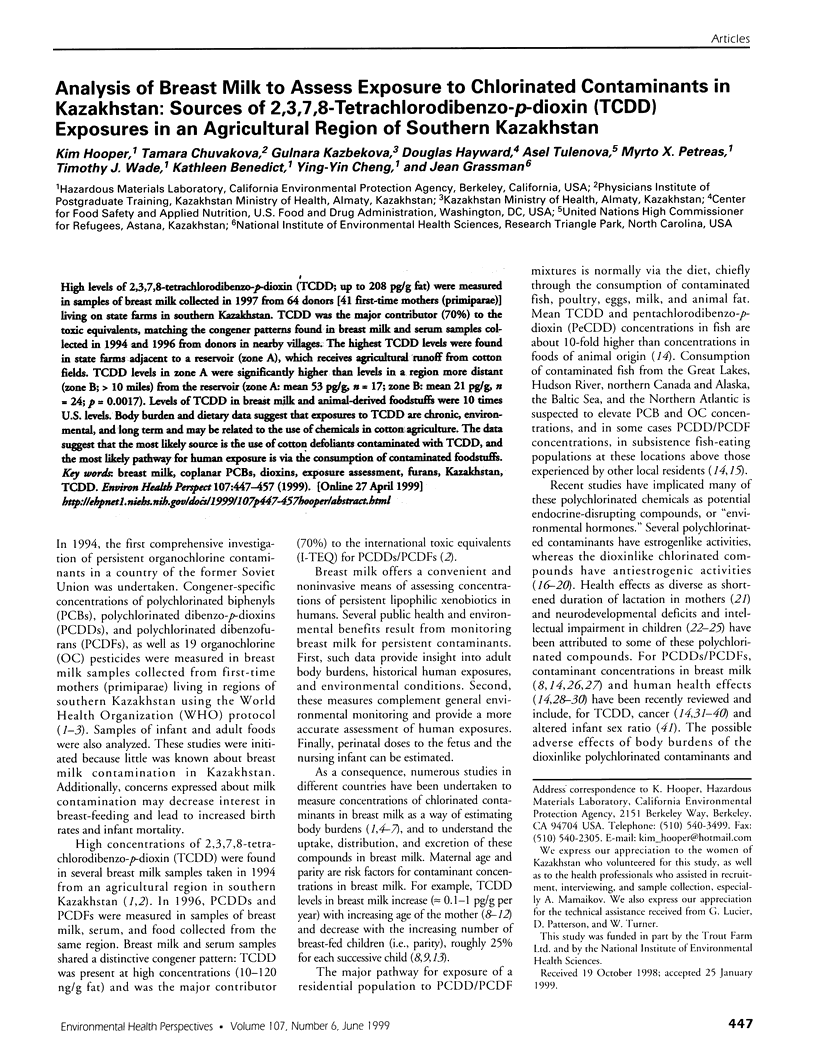
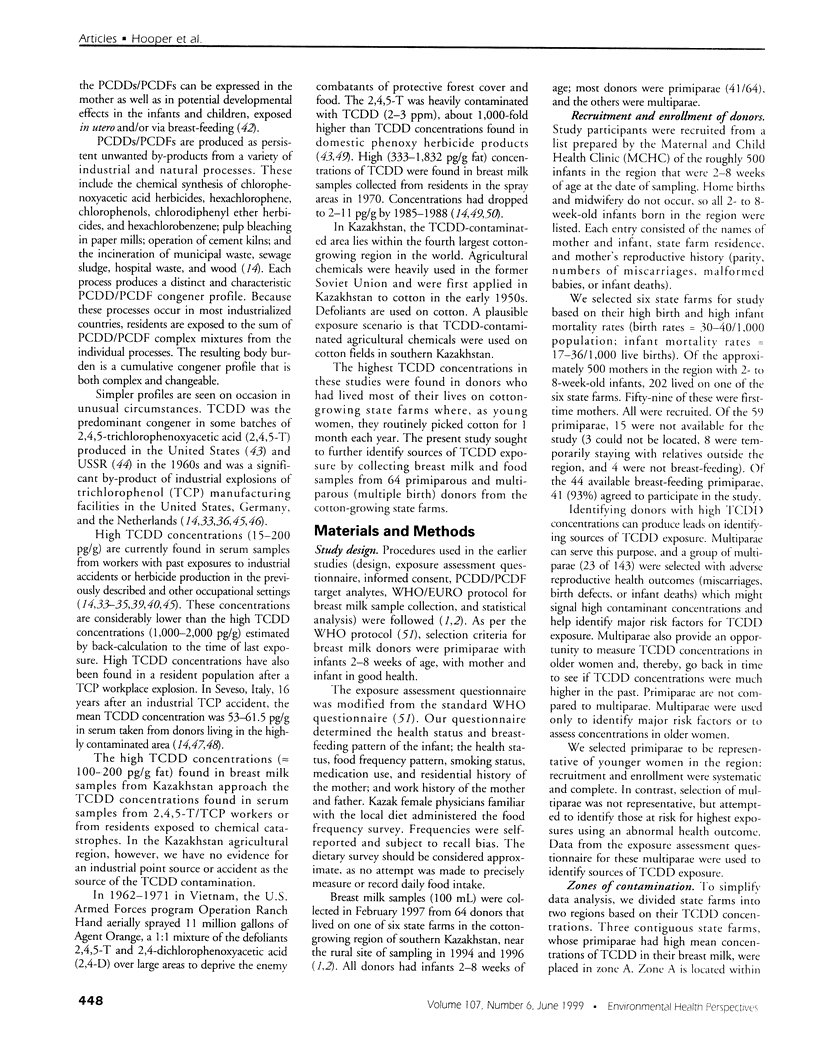
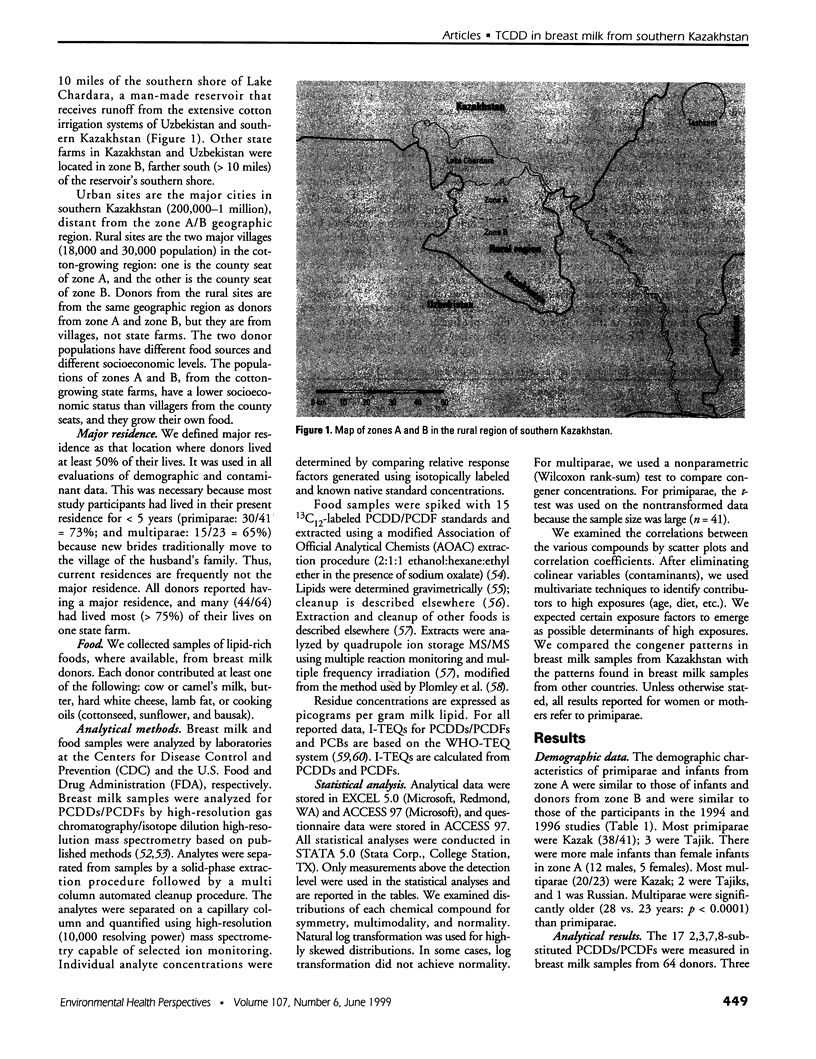

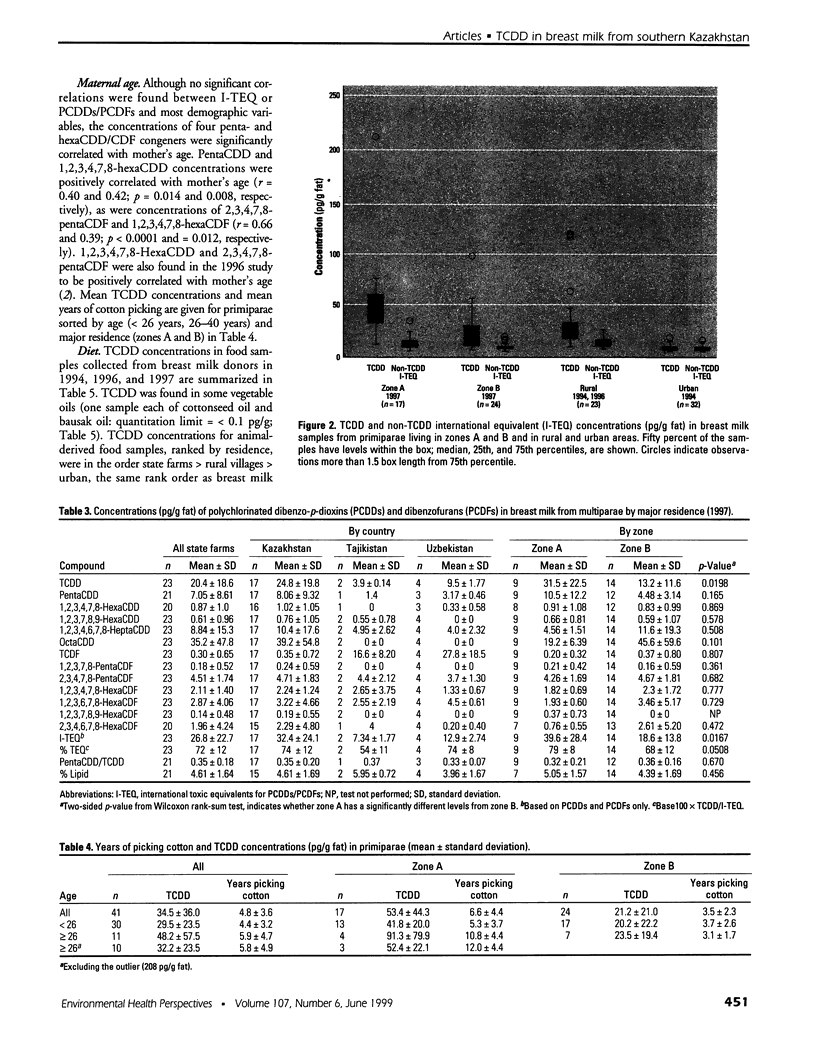
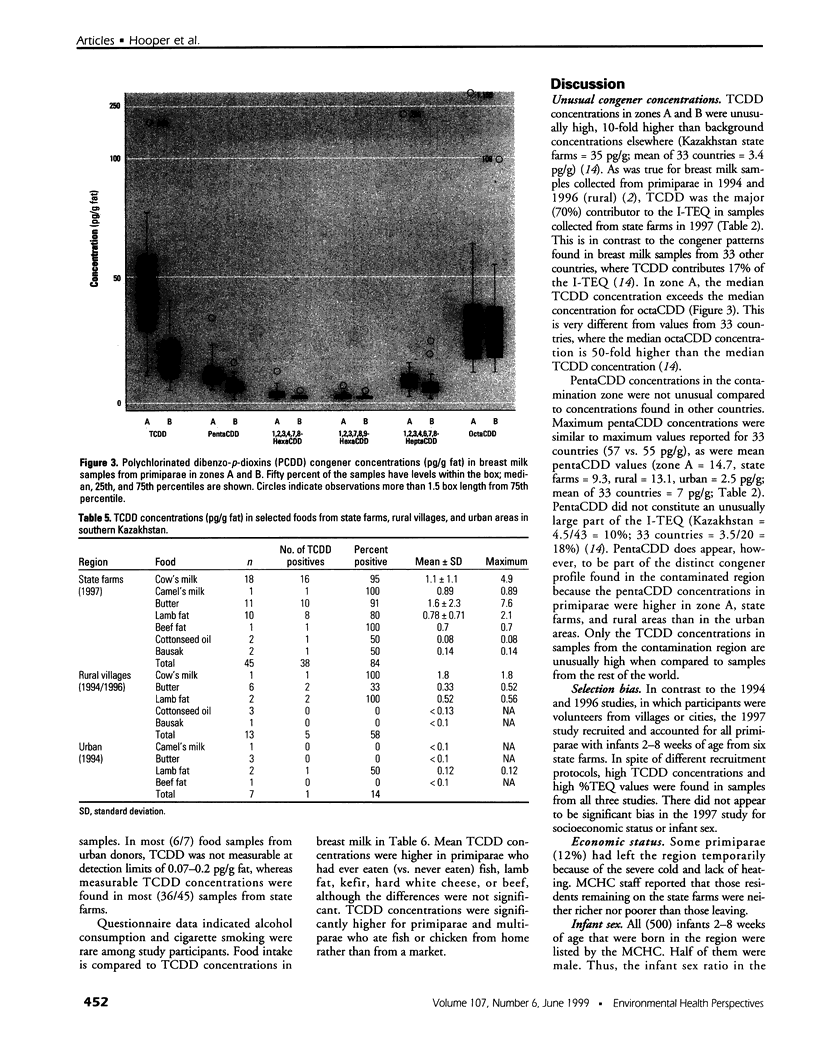
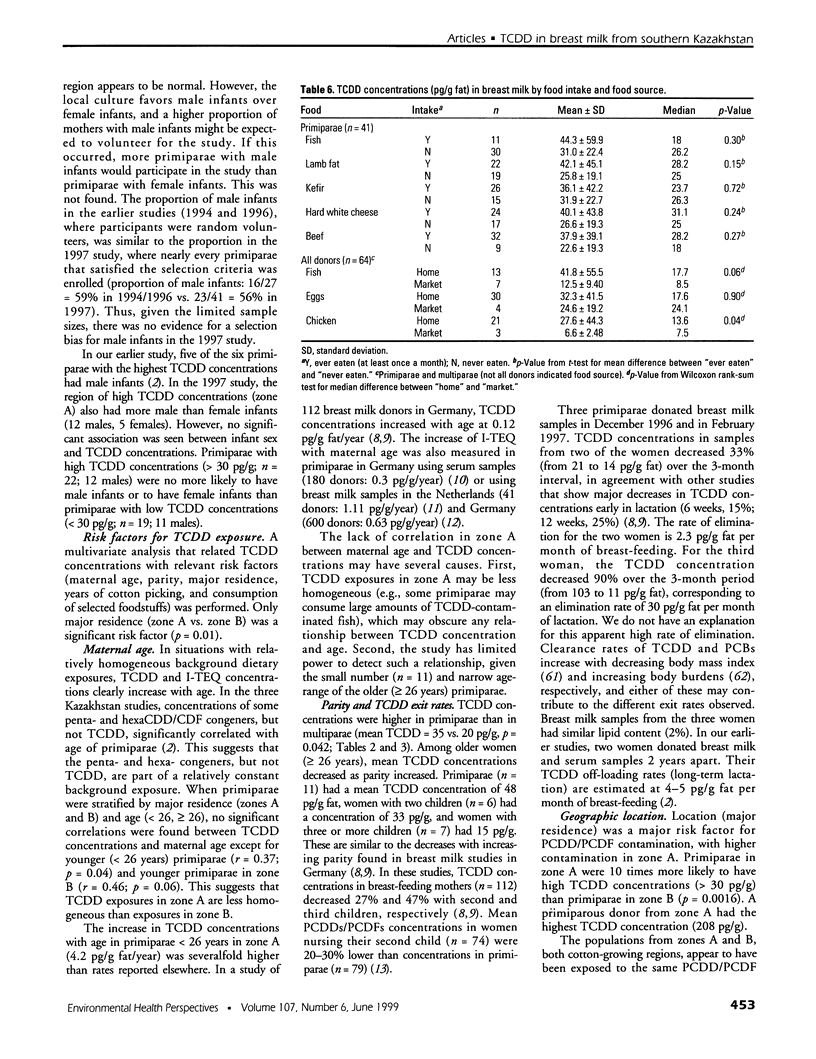
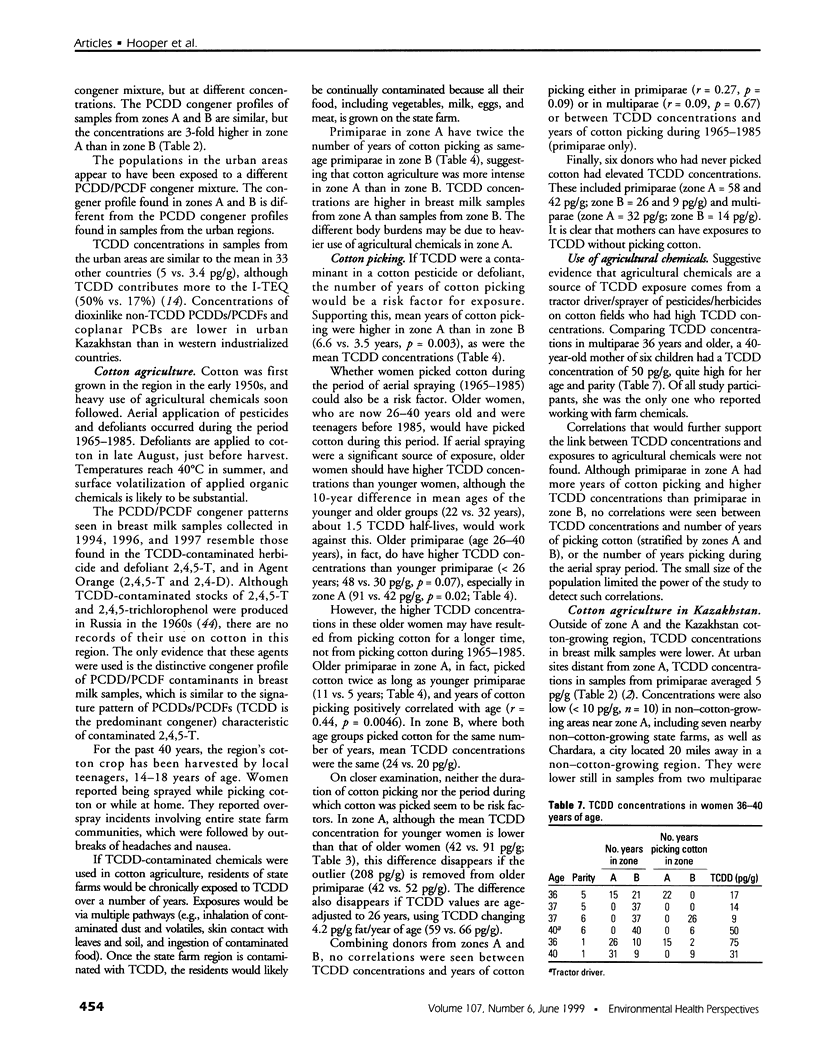
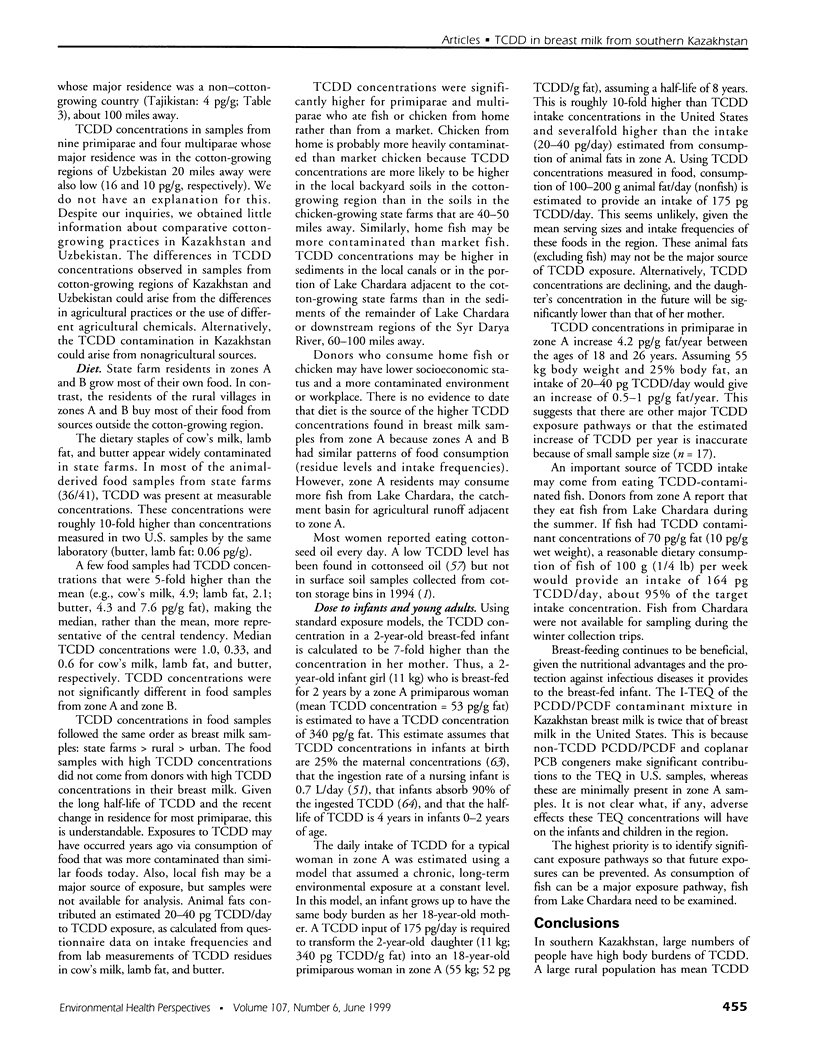
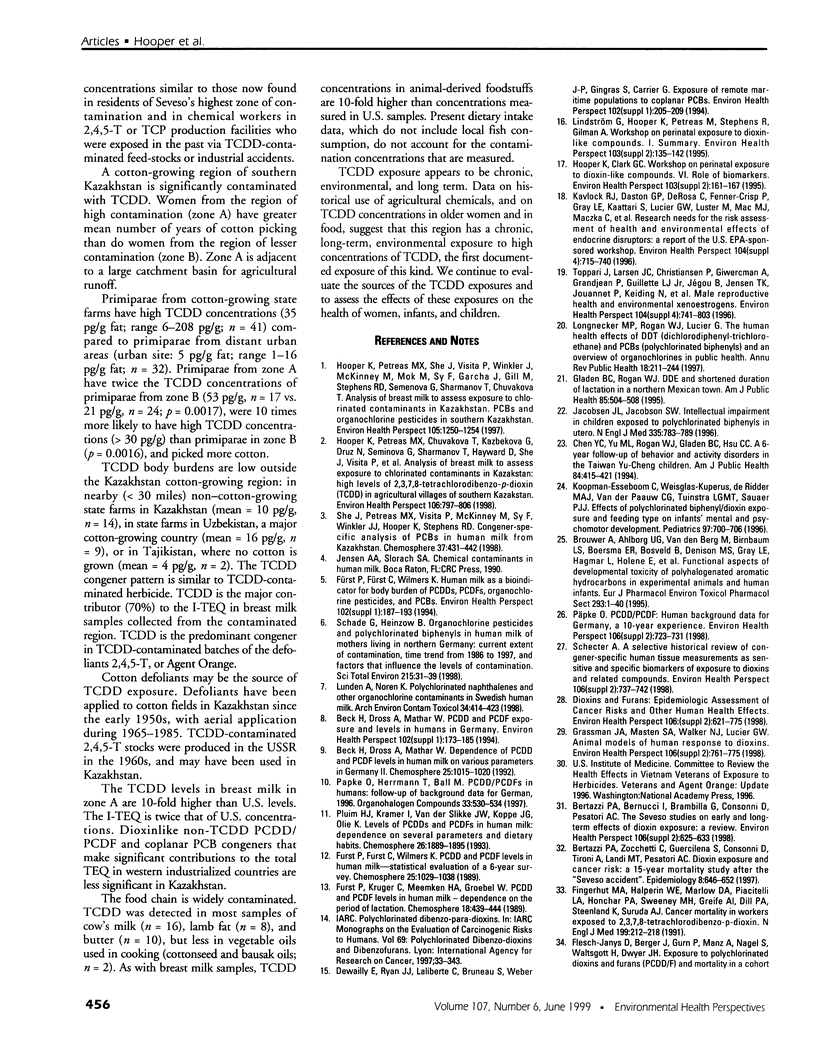
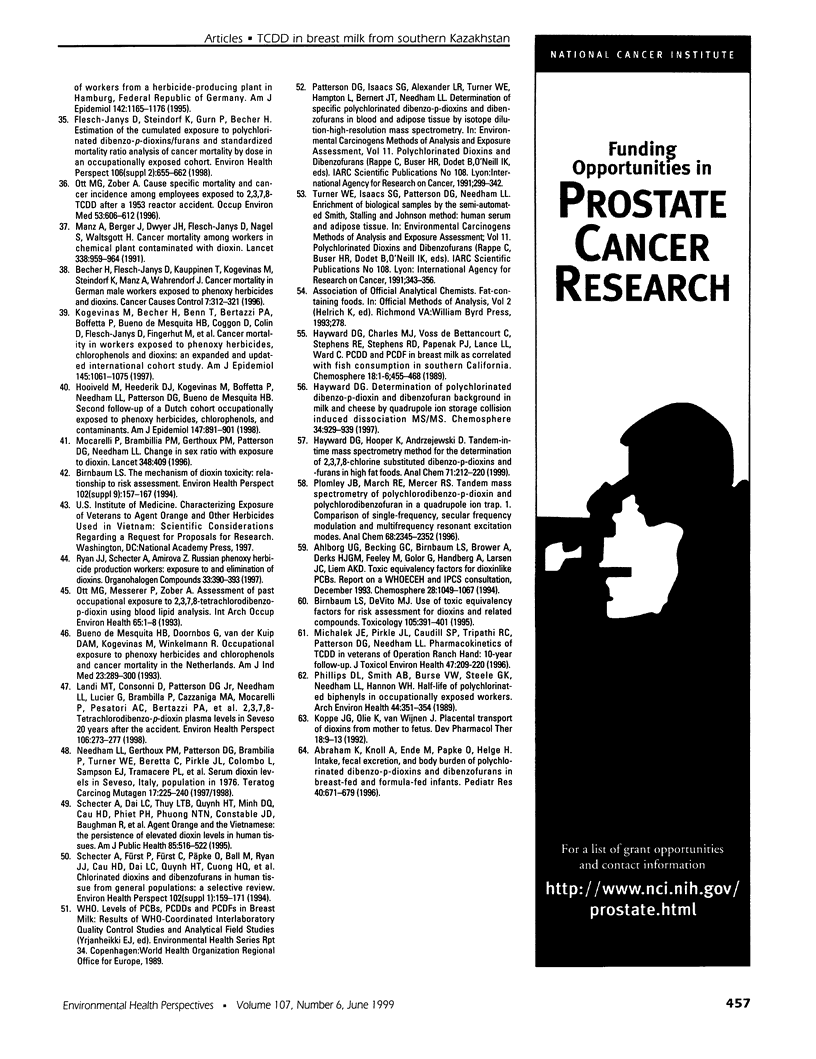
Images in this article
Selected References
These references are in PubMed. This may not be the complete list of references from this article.
- Abraham K., Knoll A., Ende M., Päpke O., Helge H. Intake, fecal excretion, and body burden of polychlorinated dibenzo-p-dioxins and dibenzofurans in breast-fed and formula-fed infants. Pediatr Res. 1996 Nov;40(5):671–679. doi: 10.1203/00006450-199611000-00005. [DOI] [PubMed] [Google Scholar]
- Becher H., Flesch-Janys D., Kauppinen T., Kogevinas M., Steindorf K., Manz A., Wahrendorf J. Cancer mortality in German male workers exposed to phenoxy herbicides and dioxins. Cancer Causes Control. 1996 May;7(3):312–321. doi: 10.1007/BF00052936. [DOI] [PubMed] [Google Scholar]
- Beck H., Dross A., Mathar W. PCDD and PCDF exposure and levels in humans in Germany. Environ Health Perspect. 1994 Jan;102 (Suppl 1):173–185. doi: 10.1289/ehp.94102s1173. [DOI] [PMC free article] [PubMed] [Google Scholar]
- Bertazzi P. A., Bernucci I., Brambilla G., Consonni D., Pesatori A. C. The Seveso studies on early and long-term effects of dioxin exposure: a review. Environ Health Perspect. 1998 Apr;106 (Suppl 2):625–633. doi: 10.1289/ehp.98106625. [DOI] [PMC free article] [PubMed] [Google Scholar]
- Bertazzi P. A., Zocchetti C., Guercilena S., Consonni D., Tironi A., Landi M. T., Pesatori A. C. Dioxin exposure and cancer risk: a 15-year mortality study after the "Seveso accident". Epidemiology. 1997 Nov;8(6):646–652. [PubMed] [Google Scholar]
- Birnbaum L. S., DeVito M. J. Use of toxic equivalency factors for risk assessment for dioxins and related compounds. Toxicology. 1995 Dec 28;105(2-3):391–401. doi: 10.1016/0300-483x(95)03237-a. [DOI] [PubMed] [Google Scholar]
- Birnbaum L. S. The mechanism of dioxin toxicity: relationship to risk assessment. Environ Health Perspect. 1994 Nov;102 (Suppl 9):157–167. doi: 10.1289/ehp.94102s9157. [DOI] [PMC free article] [PubMed] [Google Scholar]
- Brouwer A., Ahlborg U. G., Van den Berg M., Birnbaum L. S., Boersma E. R., Bosveld B., Denison M. S., Gray L. E., Hagmar L., Holene E. Functional aspects of developmental toxicity of polyhalogenated aromatic hydrocarbons in experimental animals and human infants. Eur J Pharmacol. 1995 May 26;293(1):1–40. doi: 10.1016/0926-6917(95)90015-2. [DOI] [PubMed] [Google Scholar]
- Bueno de Mesquita H. B., Doornbos G., Van der Kuip D. A., Kogevinas M., Winkelmann R. Occupational exposure to phenoxy herbicides and chlorophenols and cancer mortality in The Netherlands. Am J Ind Med. 1993 Feb;23(2):289–300. doi: 10.1002/ajim.4700230206. [DOI] [PubMed] [Google Scholar]
- Chen Y. C., Yu M. L., Rogan W. J., Gladen B. C., Hsu C. C. A 6-year follow-up of behavior and activity disorders in the Taiwan Yu-cheng children. Am J Public Health. 1994 Mar;84(3):415–421. doi: 10.2105/ajph.84.3.415. [DOI] [PMC free article] [PubMed] [Google Scholar]
- Dewailly E., Ryan J. J., Laliberté C., Bruneau S., Weber J. P., Gingras S., Carrier G. Exposure of remote maritime populations to coplanar PCBs. Environ Health Perspect. 1994 Jan;102 (Suppl 1):205–209. doi: 10.1289/ehp.94102s1205. [DOI] [PMC free article] [PubMed] [Google Scholar]
- Fingerhut M. A., Halperin W. E., Marlow D. A., Piacitelli L. A., Honchar P. A., Sweeney M. H., Greife A. L., Dill P. A., Steenland K., Suruda A. J. Cancer mortality in workers exposed to 2,3,7,8-tetrachlorodibenzo-p-dioxin. N Engl J Med. 1991 Jan 24;324(4):212–218. doi: 10.1056/NEJM199101243240402. [DOI] [PubMed] [Google Scholar]
- Flesch-Janys D., Steindorf K., Gurn P., Becher H. Estimation of the cumulated exposure to polychlorinated dibenzo-p-dioxins/furans and standardized mortality ratio analysis of cancer mortality by dose in an occupationally exposed cohort. Environ Health Perspect. 1998 Apr;106 (Suppl 2):655–662. doi: 10.1289/ehp.98106655. [DOI] [PMC free article] [PubMed] [Google Scholar]
- Fürst P., Fürst C., Wilmers K. Human milk as a bioindicator for body burden of PCDDs, PCDFs, organochlorine pesticides, and PCBs. Environ Health Perspect. 1994 Jan;102 (Suppl 1):187–193. doi: 10.1289/ehp.102-1566908. [DOI] [PMC free article] [PubMed] [Google Scholar]
- Gladen B. C., Rogan W. J. DDE and shortened duration of lactation in a northern Mexican town. Am J Public Health. 1995 Apr;85(4):504–508. doi: 10.2105/ajph.85.4.504. [DOI] [PMC free article] [PubMed] [Google Scholar]
- Grassman J. A., Masten S. A., Walker N. J., Lucier G. W. Animal models of human response to dioxins. Environ Health Perspect. 1998 Apr;106 (Suppl 2):761–775. doi: 10.1289/ehp.98106761. [DOI] [PMC free article] [PubMed] [Google Scholar]
- Hayward D. G. Determination of polychlorinated dibenzo-p-dioxin and dibenzofuran background in milk and cheese by quadrupole ion storage collision induced dissociation MS/MS. Chemosphere. 1997 Mar-Apr;34(5-7):929–939. doi: 10.1016/s0045-6535(97)00396-2. [DOI] [PubMed] [Google Scholar]
- Hayward D. G., Hooper K., Andrzejewski D. Tandem-in-time mass spectrometry method for the sub-parts-per-trillion determination of 2,3,7,8-chlorine-substituted dibenzo-p-dioxins and -furans in high-fat foods. Anal Chem. 1999 Jan 1;71(1):212–220. doi: 10.1021/ac980282+. [DOI] [PubMed] [Google Scholar]
- Hooiveld M., Heederik D. J., Kogevinas M., Boffetta P., Needham L. L., Patterson D. G., Jr, Bueno-de-Mesquita H. B. Second follow-up of a Dutch cohort occupationally exposed to phenoxy herbicides, chlorophenols, and contaminants. Am J Epidemiol. 1998 May 1;147(9):891–901. doi: 10.1093/oxfordjournals.aje.a009543. [DOI] [PubMed] [Google Scholar]
- Hooper K., Clark G. C. Workshop on perinatal exposure to dioxin-like compounds. VI. Role of biomarkers. Environ Health Perspect. 1995 Mar;103 (Suppl 2):161–167. doi: 10.1289/ehp.95103s2161. [DOI] [PMC free article] [PubMed] [Google Scholar]
- Hooper K., Petreas M. X., Chuvakova T., Kazbekova G., Druz N., Seminova G., Sharmanov T., Hayward D., She J., Visita P. Analysis of breast milk to assess exposure to chlorinated contaminants in Kazakstan: high levels of 2,3,7, 8-tetrachlorodibenzo-p-dioxin (TCDD) in agricultural villages of southern Kazakstan. Environ Health Perspect. 1998 Dec;106(12):797–806. doi: 10.1289/ehp.98106797. [DOI] [PMC free article] [PubMed] [Google Scholar]
- Jacobson J. L., Jacobson S. W. Intellectual impairment in children exposed to polychlorinated biphenyls in utero. N Engl J Med. 1996 Sep 12;335(11):783–789. doi: 10.1056/NEJM199609123351104. [DOI] [PubMed] [Google Scholar]
- Kavlock R. J., Daston G. P., DeRosa C., Fenner-Crisp P., Gray L. E., Kaattari S., Lucier G., Luster M., Mac M. J., Maczka C. Research needs for the risk assessment of health and environmental effects of endocrine disruptors: a report of the U.S. EPA-sponsored workshop. Environ Health Perspect. 1996 Aug;104 (Suppl 4):715–740. doi: 10.1289/ehp.96104s4715. [DOI] [PMC free article] [PubMed] [Google Scholar]
- Kogevinas M., Becher H., Benn T., Bertazzi P. A., Boffetta P., Bueno-de-Mesquita H. B., Coggon D., Colin D., Flesch-Janys D., Fingerhut M. Cancer mortality in workers exposed to phenoxy herbicides, chlorophenols, and dioxins. An expanded and updated international cohort study. Am J Epidemiol. 1997 Jun 15;145(12):1061–1075. doi: 10.1093/oxfordjournals.aje.a009069. [DOI] [PubMed] [Google Scholar]
- Koopman-Esseboom C., Weisglas-Kuperus N., de Ridder M. A., Van der Paauw C. G., Tuinstra L. G., Sauer P. J. Effects of polychlorinated biphenyl/dioxin exposure and feeding type on infants' mental and psychomotor development. Pediatrics. 1996 May;97(5):700–706. [PubMed] [Google Scholar]
- Koppe J. G., Olie K., van Wijnen J. Placental transport of dioxins from mother to fetus. II. PCBs, dioxins and furans and vitamin K metabolism. Dev Pharmacol Ther. 1992;18(1-2):9–13. [PubMed] [Google Scholar]
- Landi M. T., Consonni D., Patterson D. G., Jr, Needham L. L., Lucier G., Brambilla P., Cazzaniga M. A., Mocarelli P., Pesatori A. C., Bertazzi P. A. 2,3,7,8-Tetrachlorodibenzo-p-dioxin plasma levels in Seveso 20 years after the accident. Environ Health Perspect. 1998 May;106(5):273–277. doi: 10.1289/ehp.98106273. [DOI] [PMC free article] [PubMed] [Google Scholar]
- Lindström G., Hooper K., Petreas M., Stephens R., Gilman A. Workshop on perinatal exposure to dioxin-like compounds. I. Summary. Environ Health Perspect. 1995 Mar;103 (Suppl 2):135–142. doi: 10.1289/ehp.103-1518837. [DOI] [PMC free article] [PubMed] [Google Scholar]
- Longnecker M. P., Rogan W. J., Lucier G. The human health effects of DDT (dichlorodiphenyltrichloroethane) and PCBS (polychlorinated biphenyls) and an overview of organochlorines in public health. Annu Rev Public Health. 1997;18:211–244. doi: 10.1146/annurev.publhealth.18.1.211. [DOI] [PubMed] [Google Scholar]
- Lundén A., Norén K. Polychlorinated naphthalenes and other organochlorine contaminants in Swedish human milk, 1972-1992. Arch Environ Contam Toxicol. 1998 May;34(4):414–423. doi: 10.1007/s002449900338. [DOI] [PubMed] [Google Scholar]
- Manz A., Berger J., Dwyer J. H., Flesch-Janys D., Nagel S., Waltsgott H. Cancer mortality among workers in chemical plant contaminated with dioxin. Lancet. 1991 Oct 19;338(8773):959–964. doi: 10.1016/0140-6736(91)91835-i. [DOI] [PubMed] [Google Scholar]
- Michalek J. E., Pirkle J. L., Caudill S. P., Tripathi R. C., Patterson D. G., Jr, Needham L. L. Pharmacokinetics of TCDD in veterans of Operation Ranch Hand: 10-year follow-up. J Toxicol Environ Health. 1996 Feb 23;47(3):209–220. doi: 10.1080/009841096161744. [DOI] [PubMed] [Google Scholar]
- Mocarelli P., Brambilla P., Gerthoux P. M., Patterson D. G., Jr, Needham L. L. Change in sex ratio with exposure to dioxin. Lancet. 1996 Aug 10;348(9024):409–409. doi: 10.1016/s0140-6736(05)65030-1. [DOI] [PubMed] [Google Scholar]
- Needham L. L., Gerthoux P. M., Patterson D. G., Jr, Brambilla P., Turner W. E., Beretta C., Pirkle J. L., Colombo L., Sampson E. J., Tramacere P. L. Serum dioxin levels in Seveso, Italy, population in 1976. Teratog Carcinog Mutagen. 1997;17(4-5):225–240. [PubMed] [Google Scholar]
- Ott M. G., Messerer P., Zober A. Assessment of past occupational exposure to 2,3,7,8-tetrachlorodibenzo-p-dioxin using blood lipid analyses. Int Arch Occup Environ Health. 1993;65(1):1–8. doi: 10.1007/BF00586050. [DOI] [PubMed] [Google Scholar]
- Phillips D. L., Smith A. B., Burse V. W., Steele G. K., Needham L. L., Hannon W. H. Half-life of polychlorinated biphenyls in occupationally exposed workers. Arch Environ Health. 1989 Nov-Dec;44(6):351–354. doi: 10.1080/00039896.1989.9935905. [DOI] [PubMed] [Google Scholar]
- Päpke O. PCDD/PCDF: human background data for Germany, a 10-year experience. Environ Health Perspect. 1998 Apr;106 (Suppl 2):723–731. doi: 10.1289/ehp.106-1533397. [DOI] [PMC free article] [PubMed] [Google Scholar]
- Schade G., Heinzow B. Organochlorine pesticides and polychlorinated biphenyls in human milk of mothers living in northern Germany: current extent of contamination, time trend from 1986 to 1997 and factors that influence the levels of contamination. Sci Total Environ. 1998 Apr 23;215(1-2):31–39. doi: 10.1016/s0048-9697(98)00008-4. [DOI] [PubMed] [Google Scholar]
- Schecter A. A selective historical review of congener-specific human tissue measurements as sensitive and specific biomarkers of exposure to dioxins and related compounds. Environ Health Perspect. 1998 Apr;106 (Suppl 2):737–742. doi: 10.1289/ehp.98106737. [DOI] [PMC free article] [PubMed] [Google Scholar]
- Schecter A., Dai L. C., Thuy L. T., Quynh H. T., Minh D. Q., Cau H. D., Phiet P. H., Nguyen N. T., Constable J. D., Baughman R. Agent Orange and the Vietnamese: the persistence of elevated dioxin levels in human tissues. Am J Public Health. 1995 Apr;85(4):516–522. doi: 10.2105/ajph.85.4.516. [DOI] [PMC free article] [PubMed] [Google Scholar]
- Schecter A., Fürst P., Fürst C., Päpke O., Ball M., Ryan J. J., Hoang D. C., Le C. D., Hoang T. Q., Cuong H. Q. Chlorinated dioxins and dibenzofurans in human tissue from general populations: a selective review. Environ Health Perspect. 1994 Jan;102 (Suppl 1):159–171. doi: 10.1289/ehp.94102s1159. [DOI] [PMC free article] [PubMed] [Google Scholar]
- She J., Petreas M. X., Visita P., McKinney M., Sy F. J., Winkler J. J., Hooper K., Stephens R. D. Congener-specific analysis of PCBs in human milk from Kazakhstan. Chemosphere. 1998 Aug;37(3):431–442. doi: 10.1016/s0045-6535(98)00059-9. [DOI] [PubMed] [Google Scholar]
- Toppari J., Larsen J. C., Christiansen P., Giwercman A., Grandjean P., Guillette L. J., Jr, Jégou B., Jensen T. K., Jouannet P., Keiding N. Male reproductive health and environmental xenoestrogens. Environ Health Perspect. 1996 Aug;104 (Suppl 4):741–803. doi: 10.1289/ehp.96104s4741. [DOI] [PMC free article] [PubMed] [Google Scholar]





